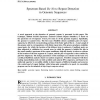Free Online Productivity Tools
i2Speak
i2Symbol
i2OCR
iTex2Img
iWeb2Print
iWeb2Shot
i2Type
iPdf2Split
iPdf2Merge
i2Bopomofo
i2Arabic
i2Style
i2Image
i2PDF
iLatex2Rtf
Sci2ools
JCB
2008
2008
Spectrum-Based De Novo Repeat Detection in Genomic Sequences
A novel approach to the detection of genomic repeats is presented in this paper. The technique, dubbed SAGRI (Spectrum Assisted Genomic Repeat Identifier), is based on the spectrum (set of sequence k-mers, for some k) of the genomic sequence. Specifically, the genome is scanned twice. The first scan (FindHit) detects candidate pairs of repeatsegments, by effectively reconstructing portions of the Euler path of the .k 1/-mer graph of the genome only in correspondence with likely repeat sites. This process produces candidate repeat pairs, for which the location of the leftmost term is unknown. Candidate pairs are then subjected to validation in a second scan, in which the genome is labelled for hits in the (much smaller) spectrum of the repeat candidates: high hit density is taken as evidence of the location of the first segment of a repeat, and the pair of segments is then certified by pairwise alignment. The design parameters of the technique are selected on the basis of a careful pro...
| Added | 13 Dec 2010 |
| Updated | 13 Dec 2010 |
| Type | Journal |
| Year | 2008 |
| Where | JCB |
| Authors | Huy Hoang Do, Kwok Pui Choi, Franco P. Preparata, Wing-Kin Sung, Louxin Zhang |
Comments (0)

